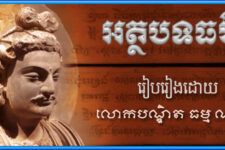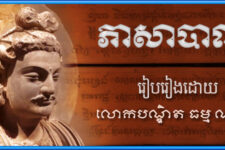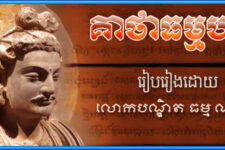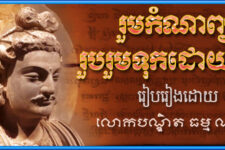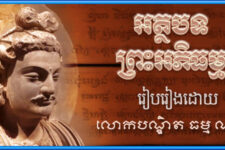ពុទ្ធវចនៈក្នុងធម្មបទ គាថាទី ១៩-២០
រៀនហើយមិនប្រតិបត្តិ មិនទទួលផលសមនឹងការរៀន
LEARNING WITHOUT PRACTICE IS OF NO WORTH
बहुम्पि चे संहित भासमानो, न तक्करो होति नरो पमत्तो।
गोपोव गावो गणयं परेसं, न भागवा सामञ्ञस्स होति॥
अप्पम्पि चे संहित भासमानो, धम्मस्स होति अनुधम्मचारी।
रागञ्च दोसञ्च पहाय मोहं, सम्मप्पजानो सुविमुत्तचित्तो।
अनुपादियानो इध वा हुरं वा, स भागवा सामञ्ञस्स होति॥
ពហុម្បិ ចេ សំហិត ភាសមានោ, ន តក្ករោ ហោតិ នរោ បមត្តោ;
គោបោវ គាវោ គណយំ បរេសំ, ន ភាគវា សាមញ្ញស្ស ហោតិ ។
អ្នកទន្ទេញចាំគម្ពីរបានច្រើន តែប្រមាទ មិនបដិបត្តិតាមពាក្យប្រៀនប្រដៅ រមែងមិនបានទទួលផលដែលគប្បីបានទទួលអំពីការបួស ដូចគង្វាលគោរាប់គោឱ្យអ្នកដទៃដូច្នោះ ។
អប្បម្បិ ចេ សំហិត ភាសមានោ, ធម្មស្ស ហោតិ អនុធម្មចារី;
រាគញ្ច ទោសញ្ច បហាយ មោហំ, សម្មប្បជានោ សុវិមុត្តចិត្តោ;
អនុបាទិយានោ ឥធ វា ហុរំ វា, ស ភាគវា សាមញ្ញស្ស ហោតិ។
ទោះបីទន្ទេញចាំគម្ពីរបានតិច តែបដិបត្តិប្រពៃតាមធម៌ លះរាគៈទោសៈមោហៈបាន ដឹងច្បាស់ មានចិត្តរួចផុតស្រឡះ មិនប្រកាន់មាំ ទាំងបច្ចុប្បន្ននិងអនាគត គេរមែងបានទទួលផលដែលគប្បីបានទទួលអំពីការបួស ។
Bahumpi ce saṃhita(1) bhāsamāno, na takkaro hoti naro pamatto;
Gopova gāvo gaṇayaṃ paresaṃ, na bhāgavā sāmaññassa(2) hoti.
Though much he recites the Sacred Texts, but acts not accordingly, that heedless man is like a cowherd who counts others’ kine. He has no share in the fruits of the Holy Life.
Appampi ce saṃhita bhāsamāno, dhammassa hoti anudhammacārī;
Rāgañca dosañca pahāya mohaṃ, sammappajāno suvimuttacitto;
Anupādiyāno idha vā huraṃ vā, sa bhāgavā sāmaññassa hoti.
Though little he recites the Sacred Texts, but acts in accordance with the teaching, forsaking lust, hatred and ignorance, truly knowing, with mind well freed, clinging to naught here and hereafter, he shares the fruits of the Holy Life.
——————————————-
Story:
There were two monks –one a worlding but well-versed in the Dhamma, the other an Arahant though not so erudite. The worlding did not practice what he knew; the one who knew little practiced the Dhamma and, realizing Nibbāna, enjoyed the fruits of the Holy Life. The scholarly monk desired to embarrass the other by putting some intricate questions in the presence of the Buddha. Knowing well his base motive, the Buddha raised some questions connected with the realization of the Dhamma. The Arahant answered them all from personal experience, but the other could not as he had not attained to any Paths of Sainthool. Thereupon the Buddha praised the Arahant who practiced His teaching, though possessing less knowledge of the Dhamma.
——————————————-
(1) Saṃhita = saṃ + hita, is that which is associated with what is beneficial. Commentary states that saṃhita is a synonym for the Tipiṭaka, the three Baskests, taught by the Buddha, namely, Vinaya Piṭaka, the Basket of Discipline, Sutta Piṭaka, the Basket of Discourses, and Abhidhamma Piṭaka, the Basket of Ultimate Doctrine.
(2) Sāmaññassa = lit., the state of a monk or ascetic, i.e., the Holy Life.
According to Buddhism learning is of no avail without actual practice. As such Buddhism is not a mere philosophy, but a unique Path of Enlightenment.
——————————————-
Source: Dhammapada: yamaka vagga; translated with brief stories by Nārada Thera (2522-1978)
ប្រែពីបាឡីជាភាសាខ្មែរដោយ តាអារាមប៊យ ៥.៨.២០១៩


🔸កំណែចុងក្រោយ Last Updated on February 24, 2025 by Johnny ចន្នី
